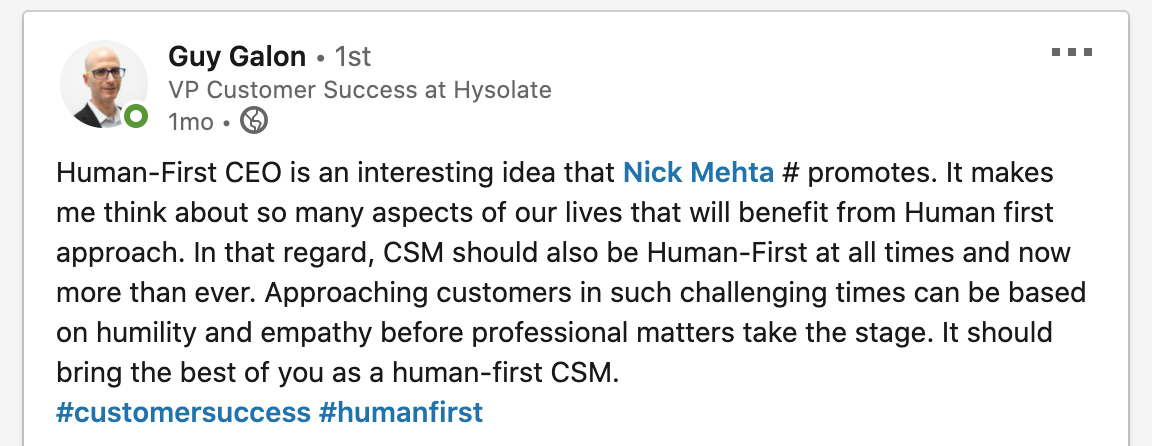Sometimes an outsider can observe something so obvious that you just can’t identify yourself.
I’ve written about how the approach of the CEO needs to change, especially during this tumultuous year. CEOs need to think about all of their stakeholders as people and thereby adopt a Human-first approach. And 2020 is making that vision a reality. CEOs now see employees through whole new lenses, thinking about their physical health, mental health, and family situation, given the impact of COVID-19 on the world. They are looking at customers as true partners, with both sides getting the other through this challenging economy. And they view their role in the community more thoughtfully, with a need to address issues around justice and equality.
I’ve always found that “human-first” captures the spirit of what Customer Success is all about. It’s about viewing your client not as a transaction or as a deal, but instead as a human being.
What I didn’t realize is how perfect a parallel Human-first is as a rallying cry for the day-to-day job of a CSM. It took a conversation with the thoughtful CS leader Guy Galon, VP Customer Success at Hysolate, to recognize this.

As I think of the Human-first CSMs that I know, I see them exhibit the following behaviors.
1. Human-first CSMs see clients not as companies but instead as a “bunch of people.”
It’s easy to look at your CSM and/or CRM software and think that your job as a CSM is to manage “accounts.” The reality is that the notion of an “account” is dated.
Customers buy, adopt, renew, and expand as individuals. A big reason the CSM job exists is to align a customer to value across Decision Makers, Champions, Users, and the like.
Human-first CSMs don’t get lulled into thinking their job is just managing a “book of clients.” To paraphrase an old movie, “customers are made of people.”
2. Human-first CSMs realize not every person at the client has the same goals.
In the same vein of point 1, humans don’t always agree.
I always laugh (internally) when someone says, “what are [big company]’s goals?” The answer is there are a set of goals for each stakeholder in said big company.
CSMs that get this concept build Success Plans for each key stakeholder and try to link them up when possible. They are willing to live in a world where people at clients don’t always agree, and they constantly work to build consensus.
3. Human-first CSMs are connectors.
If you took every request by every customer to every CSM, I think one of the most common questions would be, “do you have a customer like me?”
Customers want to connect – to learn, share, and sometimes just to commiserate.
Leading CSMs are like a human version of LinkedIn. They know their company’s client base well. They understand the person they are talking to. They think about issues like industry, use case, business model, personality, and the like. They combine all of this knowledge to suggest and broker introductions.
4. Human-first CSMs drive success for the people at their customers.
Corey Thomas, CEO of publicly-traded security software company Rapid7, spoke at Pulse a few years ago about Customer Success from a CEO point of view. He had a novel idea. For him, success isn’t just adoption/renewal/etc. Nor is it just helping their customers hit their business goals. In Corey’s words, success was about helping humans at your clients to succeed professionally – in terms of their career trajectory.
To put it simply, there is no better form of Customer Success than getting the humans at your client promoted.
5. Human-first CSMs help their clients’ careers beyond their current company.
The relationship with the human at your client doesn’t need to end when they leave their job. Some of the greatest moments of satisfaction at Gainsight have been when we helped client CSMs, operations people, and CS execs find new opportunities. Personally, I have made hundreds of introductions and love following the thriving careers of our clients.
It’s easy to get lost in the data, analytics, and KPIs. We must always remember to take a step back and see the humans in it all.

